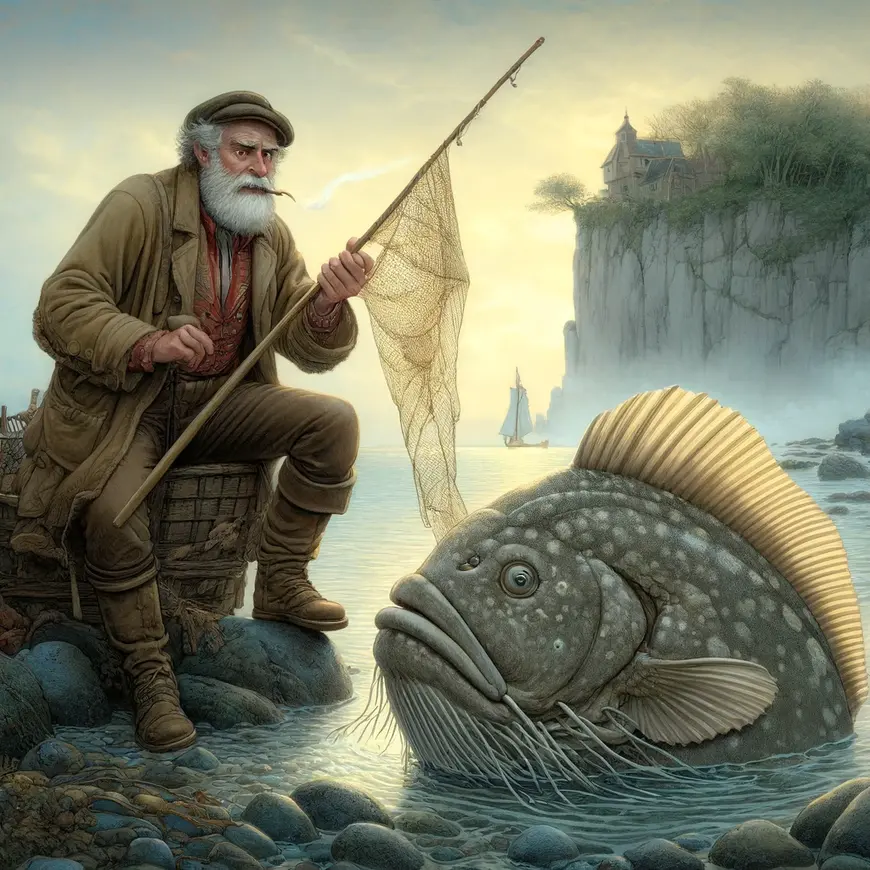“The Flounder”: Günter Grass’ Whimsical Culinary Odyssey through History and Feminism
Prepare for a literary feast unlike any other as Günter Grass takes readers on a whimsical journey in “The Flounder.” This culinary odyssey is not just a novel; it’s a tapestry of history, feminism, and gastronomic delights woven together with Grass’ signature blend of satire and storytelling. Join us as we navigate the rich layers of this tale, exploring the intricacies of time, gender, and the peculiar charm of a talking fish.
A Culinary Tapestry: A Feast for the Imagination
“The Flounder” opens with an unusual premise—a man, a woman, and a talking flounder. Grass, a literary maestro, skillfully blends myth, folklore, and his own brand of magic realism to create a narrative that is as deliciously eccentric as it is intellectually nourishing.
At its core, the novel is a culinary journey through time. Grass serves up a sumptuous banquet of historical eras, inviting readers to savor the flavors of the Stone Age, the Middle Ages, and the tumultuous 20th century. The narrative, like a well-prepared dish, is rich and complex, leaving readers hungry for more with each turn of the page.

The Talking Flounder: A Piscatorial Philosopher
The titular flounder is no ordinary fish; it’s a piscatorial philosopher with the gift of gab. Grass ingeniously uses this fantastical element to serve as a narrator and commentator on the unfolding events. The flounder becomes a witty observer, offering insights and reflections that add a layer of whimsy to the narrative.
Through the flounder’s eyes (or should we say fins?), readers gain a unique perspective on the complexities of human relationships, gender dynamics, and the ever-evolving tapestry of history. The talking flounder is not merely a plot device; it’s a narrative spice that enhances the flavor of Grass’ storytelling.
The Feminist Fable: An Exploration of Gender Dynamics
Beneath the surface of this culinary romp lies a powerful feminist fable. Grass, known for his exploration of societal issues, deftly delves into the theme of gender dynamics, using the character of the flounder to frame a narrative that spans centuries.
The novel follows the lives of three women—Alina, Hildegard, and the modern-day narrator—as they navigate the challenges, triumphs, and absurdities of their respective times. Grass weaves a thread of feminist consciousness, exploring how these women grapple with societal expectations, patriarchy, and the perennial struggle for autonomy.
Alina: A Stone Age Spit-Roaster with Agency
Alina, the Stone Age protagonist, emerges as a symbol of feminine strength and resourcefulness. In a world dominated by primal instincts and survival challenges, Alina defies stereotypes. Grass presents her not as a passive observer of history but as an active participant, challenging the notion that women in ancient times were mere bystanders.
Alina’s journey is a testament to Grass’ ability to infuse historical fiction with modern sensibilities. As a spit-roaster in the Stone Age, Alina engages in culinary rituals that serve as a precursor to the themes of sustenance and empowerment that resonate throughout the novel.
Hildegard: A Medieval Midwife with a Modern Mindset
Fast forward to the Middle Ages, and readers are introduced to Hildegard, a midwife with a penchant for herbs, healing, and an enlightened worldview. Grass portrays Hildegard as a woman ahead of her time, challenging the societal norms of her era.
Hildegard’s narrative is a delightful blend of medieval mysticism and pragmatic wisdom. Grass uses her character to explore the intersections of science, superstition, and the timeless pursuit of knowledge. Through Hildegard, he underscores the resilience of women who, despite the constraints of their times, dared to question and challenge the status quo.
The Modern Narrator: A Culinary Explorer in the 20th Century
The narrative threads culminate in the 20th century, where Grass introduces readers to the modern-day narrator—a woman navigating the complexities of contemporary life, relationships, and culinary experimentation. In this section, Grass adds a touch of meta-narrative, blurring the lines between fiction and reality.
The modern narrator, much like her historical counterparts, grapples with the ever-shifting dynamics of gender roles. Grass uses her character to reflect on the progress made and the challenges that persist in the quest for gender equality. The culinary explorations in this era serve as a metaphor for the constant evolution of societal norms and individual autonomy.
Culinary Delights: Food as a Metaphor for Life
In “The Flounder,” Grass elevates food to the status of a central character. Culinary delights become metaphors for life’s experiences, societal changes, and the sustenance needed to navigate the complexities of existence.
From Stone Age spit-roasting rituals to medieval herb-infused concoctions and modern-day culinary experiments, Grass weaves a narrative that celebrates the transformative power of food. Each meal, recipe, and culinary escapade becomes a lens through which readers can explore the cultural, social, and personal dimensions of the human experience.
Satirical Wit: Grass’ Trademark Narrative Style
Günter Grass is renowned for his satirical wit, and “The Flounder” is no exception. The novel brims with humor, irony, and a playful irreverence that characterizes Grass’ unique narrative style. His ability to infuse weighty themes with levity adds a layer of accessibility to the novel, making it engaging for readers of various tastes.
Grass uses satire not only to entertain but also to provoke thought. Through the antics of the talking flounder, the eccentricities of historical figures, and the humorous observations on societal norms, Grass encourages readers to view the world with a discerning eye and a hearty laugh.

Historical Tapestry: Blurring Fact and Fiction
“The Flounder” is a testament to Grass’ skill in blurring the lines between fact and fiction. Historical figures and events are seamlessly woven into the narrative, creating a tapestry where reality and fantasy coexist. Grass plays with historical accuracy, infusing the novel with an anachronistic charm that keeps readers on their toes.
This interplay of fact and fiction adds an extra layer of intrigue, prompting readers to question the boundaries of historical storytelling. Grass invites us to revel in the joy of storytelling itself, where the fantastical can coexist with the factual, creating a narrative that transcends the limitations of traditional historical fiction.
Culinary Symbolism: The Flounder as Allegory
The flounder, beyond its role as a talking narrator, serves as a potent symbol within the narrative. Grass uses the flounder as an allegory for the cyclical nature of history, the complexities of gender relations, and the inevitability of change.
As the flounder traverses through time, witnessing the lives of the three women and commenting on the ebb and flow of societal norms, it becomes a mirror reflecting the ever-changing tides of human existence. The flounder’s role is not confined to mere commentary; it embodies the novel’s exploration of the interconnectivity between humanity, history, and the culinary arts.
Conclusion “The Flounder”: A Literary Banquet of History, Feminism, and Whimsy
In “The Flounder,” Günter Grass invites readers to a literary banquet where history, feminism, and whimsy converge. The novel is a celebration of the human spirit, encapsulated in the lives of three remarkable women and narrated by an extraordinary fish.
Through his satirical wit, culinary explorations, and mastery of storytelling, Grass crafts a narrative that transcends the boundaries of conventional fiction. “The Flounder” is not just a novel to be read; it’s an experience to be savored—an intellectual feast that challenges, delights, and leaves readers with a newfound appreciation for the magic that can be found in the ordinary, the extraordinary, and the talking flounder in between.